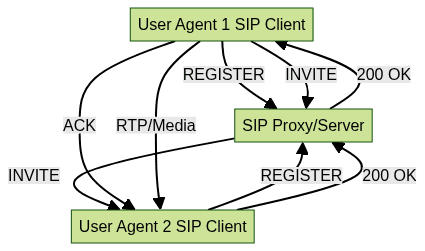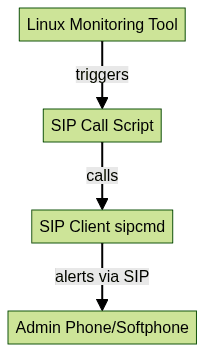Introduction to SIP Client Linux
A SIP client Linux application is a software tool enabling voice and video calls over the internet using the Session Initiation Protocol (SIP) on Linux-based systems. As VoIP (Voice over IP) becomes the backbone of modern communication, SIP clients on Linux offer flexibility, customization, and open-source power for both end-users and IT professionals. From businesses seeking affordable telephony to developers automating communication flows, SIP client linux solutions are vital. Popular choices include GUI-based softphones like Twinkle and Blink, as well as command-line tools such as sipcmd, all supporting seamless SIP protocol integration on Linux.
Understanding SIP and VoIP on Linux
The Session Initiation Protocol (SIP) is an application-layer signaling protocol used to initiate, maintain, modify, and terminate real-time sessions involving video, voice, messaging, and other communications. SIP is the core of VoIP, allowing disparate systems to connect over IP networks without traditional telephony hardware.
On Linux, VoIP leverages SIP clients to register with SIP servers or proxies, enabling users to make and receive calls, often with encryption and advanced features. SIP client linux solutions stand out against traditional telephony by being cost-effective, highly customizable, and open-source. For those looking to integrate programmable calling features, exploring a
phone call api
can further enhance your VoIP setup on Linux.
SIP clients on Linux integrate directly with SIP proxies and media servers, enabling advanced call routing, automation, and integration with open-source PBXs like Asterisk or FreeSWITCH, unlike closed, hardware-centric PBX systems.
Choosing the Right SIP Client for Linux
When selecting a SIP client linux tool, consider the following criteria:
- GUI vs CLI: Graphical interfaces (e.g., Twinkle, Blink) are user-friendly, while command-line clients (e.g., sipcmd) suit automation and scripting.
- Open-source: Most Linux SIP clients are open source, supporting transparency and community-driven development.
- Features: Look for essentials like call recording, encryption, presence, and multi-account support. If you need to add video communication to your SIP client, integrating a
Video Calling API
can be a game-changer. - Community Support: Active development and user forums ease troubleshooting and ensure security updates.
| SIP Client | GUI/CLI | License | Key Features | Community Support |
|---|---|---|---|---|
| Twinkle | GUI | GPL | Secure calls, call hold | Active |
| sipcmd | CLI | GPL | Automation, scripting | Moderate |
| Siphon | GUI | LGPL | Lightweight, legacy | Limited |
| Blink | GUI | GPL | Video, IM, multi-platform | Active |
Top SIP Clients for Linux: Detailed Overview
Twinkle SIP Client Linux
Twinkle is a robust open-source SIP softphone Linux application featuring a user-friendly GUI, secure (SRTP) calls, call transfer, and multi-account management. It's ideal for desktops and integrates well with KDE. Installing Twinkle is straightforward via package managers on most Linux distributions. For those interested in building custom voice solutions or integrating live audio features, leveraging a
Voice SDK
can complement your SIP client setup.sipcmd & Command-Line SIP Clients
sipcmd is a flexible command line SIP client for Linux, enabling automated VoIP calls, DTMF signaling, and scripting. Forks like sipcmd2 and stefanotorresi's variant add bug fixes and enhancements. CLI SIP client linux tools are perfect for automated testing, IVR systems, or batch call logging from scripts. If you’re developing cross-platform VoIP apps, especially with Flutter, you might want to explore
flutter webrtc
for real-time audio and video communication capabilities.Example: sipcmd Outbound Call Command
1sipcmd -P sip -u "user" -c "password" -w "sip.server.com" -x "c123;w5000;h"
2This command registers with a SIP server and executes a call script, automating call placement and hangup.
Blink SIP Client Linux
Blink is a modern SIP softphone with a polished GUI, supporting voice, video, and instant messaging. It's cross-platform and integrates with Linux desktop environments, offering advanced features like call recording, presence, and encryption, making it a top choice for power users. If you’re searching for a
jitsi alternative
for secure and scalable conferencing, Blink combined with other open-source solutions can be a strong contender.Siphon SIP Client Linux
Siphon is a lightweight, legacy Linux SIP client with basic call features. While not actively developed in 2025, it still serves basic needs on older systems or for testing simple SIP setups.
Installing and Configuring a SIP Client on Linux
Installing GUI SIP Clients
Twinkle Installation:
1sudo apt update
2sudo apt install twinkle
3Blink Installation:
1sudo apt update
2sudo apt install blink
3Alternatively, both are available via Flatpak or Snap for broader compatibility:
1flatpak install flathub net.agnat.twinkle
2flatpak install flathub com.icanblink.blink
3If you’re developing for Android, integrating
webrtc android
can help you extend your SIP client’s reach to mobile platforms.Installing CLI SIP Clients
sipcmd Installation (Debian/Ubuntu):
1sudo apt update
2sudo apt install sipcmd
3For the latest versions or forks, you may need to compile from source:
1git clone https://github.com/stefanotorresi/sipcmd.git
2cd sipcmd
3make
4sudo make install
5Initial Configuration and Registration
After installation, launch your SIP client and configure it with your SIP account details:
- SIP Username/Password (provided by your VoIP provider)
- SIP Server/Proxy address
- NAT Traversal: Enable STUN/TURN if behind a firewall
Example GUI configuration panel:
- SIP Account:
user@sip.example.com - Server:
sip.example.com:5060 - Transport: UDP/TCP
- Outbound Proxy: (if required)
CLI clients like sipcmd require these as command-line parameters. For those looking to add call functionality to their apps, integrating a
phone call api
can streamline the process and provide additional features.Advanced Usage: Scripting and Automation with SIP Client Linux
One of the most powerful aspects of SIP client linux tools like sipcmd is automation. You can script calls for testing, alerts, or integration with other systems. For example, triggering a SIP call on a monitoring event or sending automated DTMF sequences. If you want to build advanced calling features into your applications, consider using a
phone call api
for seamless integration.Automated Call Script Example:
1#!/bin/bash
2sipcmd -P sip -u "monitoruser" -c "securepass" -w "sip.provider.net" -x "c1234567890;w2000;dt1234;h"
3This script dials a number, waits 2 seconds, sends DTMF digits, then hangs up—ideal for automated IVR or testing.
Integration Example: SIP Call on Disk Failure (with smartd)
1smartd -M exec /path/to/sip_alert.sh
2
This shows how Linux tools integrate with SIP clients for real-time voice alerts. For iOS developers, following a
callkit tutorial
can help you implement native calling experiences on Apple devices.Troubleshooting Common Issues on SIP Client Linux
- Registration Failures: Check SIP credentials, server address, and network connectivity. Use
sipcmd -d 9for debug output. - Audio Issues: Ensure correct audio device selection and codecs. Verify firewall/NAT isn't blocking RTP packets.
- NAT/Firewall Problems: Configure STUN/TURN servers in your SIP client linux settings. Open required ports (typically UDP 5060 for SIP, 10000-20000 for RTP).
- Community Resources: Consult documentation, Linux VoIP forums, and open-source repositories for support. If you need to add video conferencing to your troubleshooting toolkit, integrating a
Video Calling API
can provide additional diagnostic and collaboration features.
Conclusion: Maximizing VoIP with SIP Client Linux
SIP client linux software empowers you to build flexible, secure, and cost-effective VoIP solutions in 2025. Whether you need a feature-rich softphone or an automated CLI tool, Linux offers robust open-source options. Choose the best SIP client linux for your requirements and unlock the full potential of voice over IP on your systems.
Want to level-up your learning? Subscribe now
Subscribe to our newsletter for more tech based insights
FAQ